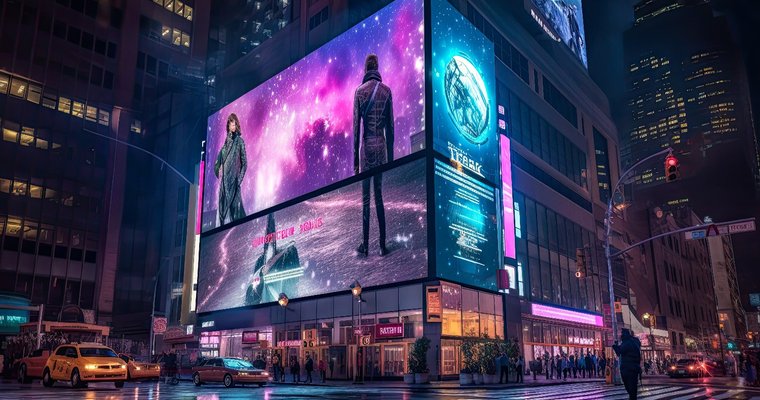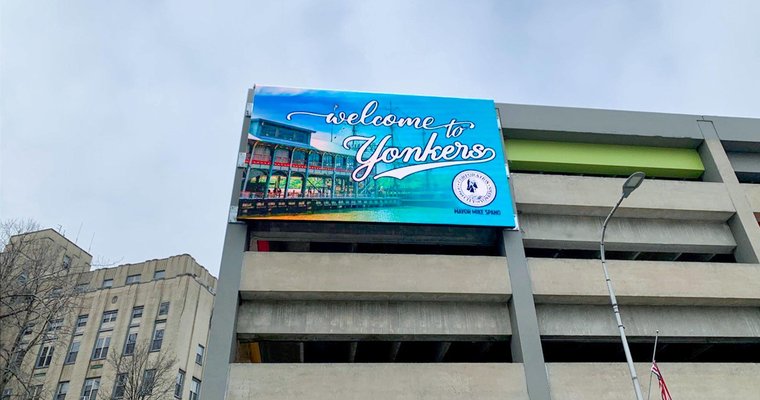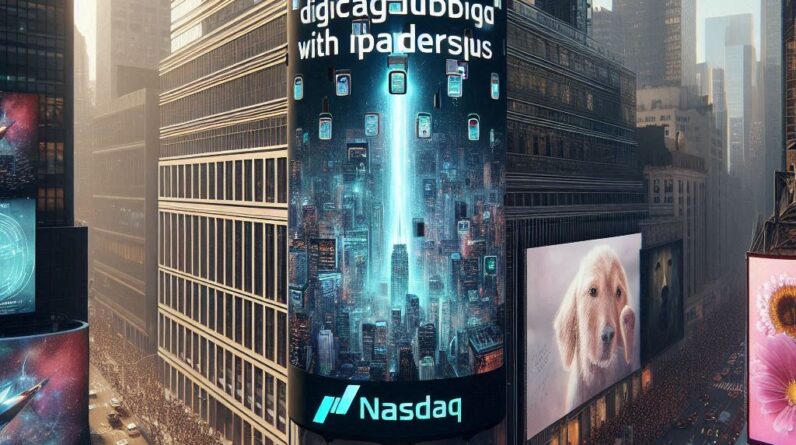
[ad_1]
Chris Grosso, CEO at Intersection, joined Daniel Brown, editor at Digital Signage Today, to discuss the top trends in digital signage, digital out of home advertising, and emerging technologies like AI.
Chris Grosso, CEO at Intersection, joined Daniel Brown, editor at Digital Signage Today, via video link from New York City to discuss the top trends in digital signage, digital out of home advertising, and emerging technologies like AI.
Interview has been edited for length and clarity.
Artificial Intelligence — friend or foe?
Brown: How would you rate the true impact of AI on the industry and what Should folks be really watching for in the in the coming year?
Grosso: I think the biggest opportunities in AI are going to be in making it easier to buy and sell out of home inventory. I think as you start to see these chatbots emerge, [we will see growth in] the ability to use that to think about what your media plan should be, to think about how your outreach should be for the marketing materials, and for thinking about how you do mocks and spec art for clients.
I think there’s going to be a lot of automation opportunities over the next 18-to-24 months. Historically, out-of-home advertising has been complicated to buy and complicated to sell. I think the ability to automate some of that back office is going to be the real near-term opportunities for AI and particularly the out-of-home space.
Brown: Are there any unforeseen opportunities or risks that folks just aren’t talking about enough?
Grosso: With respect to out-of-home advertising, I think what remains important is understanding and controlling the content on the screens, and that’s something that we’re never going to have a bot do. That’s got to be human being looking at what goes on the screens at any given time. So, the editorial control of the of the out-of-home screens has to stay with the humans.
Brown: So, it sounds like we humans aren’t going away just yet?
Grosso:No, of course not. Now, humans along with an AI help. So, what goes on the screen. You might do more customized creative that’s highly localized, where a designer might be able to do 100 pieces of creative and look at that using the AI tools, whereas before they might use one piece of creative. I think that that’s what I mean about the automation.
Or a seller might do 10 pieces of outreach [without AI], but while using an AI Chatbot, they can do 30 or 40 pieces of outreach — but you’re still going to have the human factor in this business, both in terms of what goes on the screen but also with in the relationships around buying and selling the advertising. This is more about simply making it easier, and giving the editors, the sellers, and the buyers better tools to work together.
Brown: So, we’re not looking at firms firing their entire human marketing team and replacing it with an AI – we’re still not there yet?
Grosso: I don’t think it’s ever going to be there. I think the human factor — it’s just like the way everyone needs to be in real life. You need real people running these businesses, but they can use tools, just like the computer, like the cell phone. This is no different than when everyone had to adopt the computer 30 years ago to run their business. People are going to have to adopt AI to run their business, but people still run the businesses. So, people doing the work, they might be more efficient, and the quality should go up. And I was listening to a talk referencing some studies that have been done where people got a little bit more efficient [after adopting AI tools], but the quality of what came out was much, much higher. So, I think higher quality with the same level of effort is probably where a lot of this nets out. You just get a better product. And I think that’ll help industry for sure.
Tech trends beyond AI
Brown: Moving beyond AI, what are some other upcoming tech trends you foresee in digital signage and digital OOH advertising?
Grosso: I think you are going to start to see a rise of omnichannel, where out of home becomes a key piece of the omnichannel equation. I think that you’ve now started to see a bit of a tipping point on linear television. I think people now are shifting more of their dollars to digital. There’s only so much you can buy and connect to TV. So, what’s happening is, there’s extra money. And because the industry has done a good job of hooking into those digital pipes, I do think now is the time where you’re really going to start to see a pickup on the programmatic side.
People will continue to look for audience, and out-of-home is one of the few places where you can find audience effectively. So, I do think you’re going to see a lot of strength there, particularly as we come out of the ad recession — the overall industry, not just out-of-home, but the overall advertising industry, was in ad recession last year. Advertising across all media was down this past year in 2023.I think in 2024 you’re gonna see good growth in the overall industry, and out-of-home is going to take a disproportionate amount of share.
Retail media trends
Brown: What will we see around retail media, especially as I keep reading these headlines about Amazon, Target, and other major brands getting involved in this space?
Grosso: Yeah, I think retail media is a huge, huge opportunity with a huge amount of growth. A lot of that retail media is taking place online, on the purchasing websites and apps of these companies, which is smart. I think some of that retail media is starting to move into real life in the stores, and I think eventually some of their retail media will extend outside the stores, such as the LinkNYC network, which we operate. We have hundreds of sites sitting right outside of these retail locations, and I think that migration of being able to do retail media in real life is going to be a growth driver for the out-of-home industry in the coming years.
Privacy and safety
Brown: We’ve all seen the headlines about Open.AI executive drama, along with EU regulations. Speaking as a technologist, a businessperson, and consumer, what is the balance between privacy and AI-fueled advertising?
Grosso: So, we don’t target individuals in public space. I think that’s a no-no. No one wants to see an ad targeted to them while they’re walking down the street. So that’s where I think you draw a pretty hard red line on privacy.
I think what you can do, which is appropriate, is location targeting. For example, say you’re putting an ad outside a bar. You don’t need to know who’s outside that bar to know that it’s probably a good place to put an ad for beer. So, I think location targeting where you have highly contextual ads at locations with high foot traffic makes a ton of sense. That’s retail media, ads for sports fans outside of sports venues, ads that want to reach people going out to restaurants and bars. Location as context is highly effective from an advertising perspective, but it’s also extremely privacy friendly because the location is the location — there’s nothing private about where the sign is.
Holograms and 3D — hype or reality?
Brown: Sometimes people want to hear predictions about big shiny things, like flying cars and holograms and so forth, or chips being implanted in our brains. What kind of ultra-futuristic emerging tech are we going to see? Or will we simply see more models of OLED and QLED, that sort of thing?
Grosso: I think a lot of this stuff around the holographic advertising, particularly in venues that are indoor venues, I think it’s going to be a really interesting thing that’s about to happen. I think the technology is there now, where you can do a really cool 3D holographic display with a couple of the providers. I think that’s going to be something that’s going to be pretty whiz bang. Clearly, the Sphere in Vegas has really reset the market and you’ll see stuff happening there as well.
So, I do think you’ll see stuff at the high level. You know, we’re not in that business, but I think the large-format — these incredible, large-format digital ads in premiere locations will continue to be a thing. But I also think you’re going to start seeing more true three-dimensional holographic ads in public spaces, particularly on the indoor side.
On the outdoor side, I think you’re going to continue seeing the theme of these screens in public spaces with content and programming and the importance of using the screen both for advertising but also giving people lots of value with the content.
Content strategy: add value, create experiences
Brown: Can you just say a word about the idea that you’re tailoring an experience, that it’s not just about making a sale?
Grosso: The more you bring value to your message in a way that gives the consumer real value — or aligns with things that give the consumer real value — the more effective your messaging is going to be.
As cities, marketers, and people in general want to invest in social good, this will create opportunities with municipal advertising. For instance, at Intersection, we work with cities and transit authorities. Oftentimes, the majority of the revenue we generate goes directly back to the city or the transit authority. So, I think the opportunity for municipal media, for marketers, to both spend money to meet their marketing objectives with a high degree of ROI, but at the same time, to make investments in their communities which also meet their social goals — I think the municipal media component of out-of-home advertising is a huge opportunity for marketers. And as they look to leverage this opportunity, and as their customers demand that they take social responsibility, this will become a key part of their business. Sponsoring the train system — sponsoring a rail location, or a train station, or a bus system, is a really effective way to do that.
Final thoughts
Brown: As we close the year, do you have any burning thoughts to say to the business, tech, advertising, and digital signage worlds?
Grosso: I mean, I’m an 80s kid. I think marketers really need to do well by doing good at this point. And as consumers are demanding that brands deliver that value to them — beyond the product itself — I think the market is going to have to align with environmentally and socially responsible activities. And I do think investing in municipal media — things like bus shelters, transit authorities, Wi-Fi and free Wi-Fi kiosks, airports — are a really good way to do that because you it allows the marketer to meet their marketing objectives and hit their ROI objectives — you have always got to do that, that’s the job — but at the same time, also to get all these benefits, where they’re reinvesting those marketing dollars into public assets and municipal assets.
And I think that’s an area where, you know, would make a huge difference if all the marketers put two, three, or four percent of their budgets into municipal media, that would do wonders for driving these cities, because the majority of that money will get reinvested directly back to the city, or the transit authority, or assets like bus shelters around the city.
Brown: It’s funny, I was just reading about virtuous cycles in “Invent” and “Wander” by Jeff Bezos — basically, they published his shareholder letters with a nice intro from Walter Isaacson. And he talks about using business to create these virtuous cycles that benefit everybody.
Grosso: You invest in these assets, then we can reinvest the money to build new assets that give you new marketing opportunities that you can continue to invest in. So, you build this virtuous cycle where the brands benefit, the citizens benefit, and the communities benefit from these assets — like a bus shelter. Mobility infrastructure needs to be built, and brands have an opportunity both to help build it and to benefit greatly from the advertising that runs on these platforms.
Daniel Brown is the editor of Digital Signage Today, a contributing editor for Automation & Self-Service, and an accomplished writer and multimedia content producer with extensive experience covering technology and business. His work has appeared in a range of business and technology publications, including interviews with eminent business leaders, inventors and technologists. He has written extensively on AI and the integration of technology and business strategy with empathy and the human touch. Brown is the author of two novels and a podcaster. His previous experience includes IT work at an Ivy League research institution, education and business consulting, and retail sales and management.
[ad_2]
Source link






